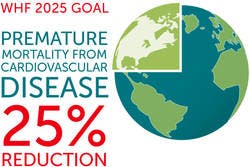Point-of-care testing (POCT) and 25x25
A new study showed that, if risk factor targets are achieved, the probability of dying from the four main noncommunicable diseases between the ages of 30 years and 70 years will decrease by approximately 20% between 2010 and 2025.(1) It is estimated that achieving the risk factor targets will delay or prevent more than 37 million deaths worldwide.(1) The 25x25 goal signifies achieving a 25% relative reduction in overall mortality from cardiovascular disease, cancer, diabetes or chronic respiratory diseases by 2025.(2) Some of the 2025 targets are below. The greatest benefits from meeting targets for the six risk factors included in the study would come from reducing tobacco smoking and lessening the burden of high blood pressure.
Data was examined from the National Vital Statistics System for 2008 to 2010 for deaths from heart disease, cancer, chronic lower respiratory disease, cerebrovascular disease, and unintentional injury, which combined accounted for 63% of deaths in 2010.(3) The analysis was restricted to deaths occurring before age 80. If all states and the District of Columbia could bring their mortality rates down to the lowest level, it was estimated that it would prevent: 91,757 deaths annually from heart disease; 84,443 deaths annually from cancer; 28,831 deaths annually from chronic lower respiratory disease; 16,973 deaths annually from cerebrovascular disease; and 36,836 deaths annually from unintentional injuries.(3) Reducing the number of earlier than expected deaths from the leading causes of death requires risk factor reduction, screening, early intervention, and successful treatment of the disease or injury.
Point-of-care testing (POCT) is defined as the performance of a diagnostic test at or near the site of the patient.(4) Point-of-care testing may take place in many settings, such as at the bedside or in the physician or dentist’s office. There are also sites like ambulances or ships, where there is little or no access to laboratory testing. POCT is now increasingly executed in the patient’s own home, by the patient themselves, in conjunction with self-management programs for disorders and conditions like diabetes or long-term oral anticoagulant therapy. The significant benefit of POCT is that it eliminates the need for transference of the sample to the laboratory. This allows for faster clinical decision making, which can lead to improved patient outcomes. Point-of-care testing is an interesting scenario because the unit cost-per-test is larger through the loss of the economy of scale offered by automation, while presenting the potential of considerable savings through facilitating rapid delivery of results, and reduction of facility costs. This is an important consideration as many health systems are planning for complete system redesign.(5)
Point-of-care testing offers new possibilities for the diagnosis and treatment of patients. The major advantage of POCT, as discussed earlier, is the rapid availability of the test result, with the possibility of earlier clinical decision making and interventions. Point-of-care testing seems to be much more susceptible to operator error than is laboratory testing.(5) The successful application of POCT may require innovative thinking and changes to traditional care pathways. Salivary diagnostics, using saliva for early detection and the first line of diagnosis for life-threatening diseases such as cancer, metabolic disorders, infections, and inflammatory diseases, and determining genetic makers, is already a reality. Novel saliva-based POCT is helping to realize the goal of making salivary diagnostics available to clinicians worldwide. Point–of–care technology that uses salivary diagnostics enables the concurrent detection of multiple biomarkers for various diseases. This is a unique situation where dentistry may be paving a new path for primary healthcare. As dental hygienists, POCT may prompt us to refer to physicians more often.RELATED | Diabetes update
References 1. Kontis V, et al "Contribution of six risk factors to achieving the 25x25 non-communicable disease mortality reduction target: a modeling study" Lancet 2014; DOI: 10.1016/S0140-6736(14)60616-4. 2. http://www.world-heart-federation.org/what-we-do/advocacy/25-by-25/. 3. Yoon P, Anderson RN, Collins JL, and Jaffe HW. Potentially preventable deaths from the five leading causes of death -- United States, 2008-2010. MMWR 2014; 63: 369-374. http://www.cdc.gov/mmwr/preview/mmwrhtml/mm6317a1.htm. 4. O’Kane MJ. Point of Care Testing—Current and Emerging Quality Perspectives. 5. St John A and Price CP. Economic Evidence and Point-of-Care Testing. Clin Biochem Rev. Aug 2013; 34(2): 61–74.More by Maria Perno Goldie:Evidence-based diagnostic standards for temporomandibular disordersCrohn's disease
References 1. Kontis V, et al "Contribution of six risk factors to achieving the 25x25 non-communicable disease mortality reduction target: a modeling study" Lancet 2014; DOI: 10.1016/S0140-6736(14)60616-4. 2. http://www.world-heart-federation.org/what-we-do/advocacy/25-by-25/. 3. Yoon P, Anderson RN, Collins JL, and Jaffe HW. Potentially preventable deaths from the five leading causes of death -- United States, 2008-2010. MMWR 2014; 63: 369-374. http://www.cdc.gov/mmwr/preview/mmwrhtml/mm6317a1.htm. 4. O’Kane MJ. Point of Care Testing—Current and Emerging Quality Perspectives. 5. St John A and Price CP. Economic Evidence and Point-of-Care Testing. Clin Biochem Rev. Aug 2013; 34(2): 61–74.More by Maria Perno Goldie:Evidence-based diagnostic standards for temporomandibular disordersCrohn's disease
Maria Perno Goldie, RDH, MS, is the editorial director of RDH eVillage FOCUS.





